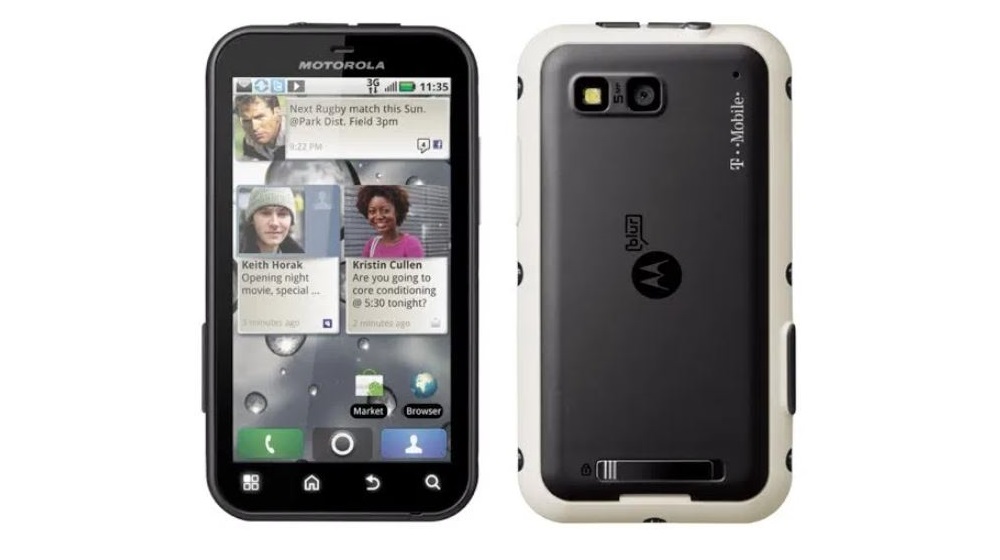Did you know: This was the first water-resistant Android phone

If you’ve ever dumped your phone in the pool or accidentally introduced it to a mug of coffee, you’ve known some real pain. Some things aren’t designed to get wet, and most smartphones used to be one of them. More recently we’ve seen a vast number of top-tier smartphones offer IP ratings as standard. However, the very first water-resistant phone was released way back in 2010.
That honor went to a niche product from Motorola. Say hello to the Motorola Defy.
Defying convention

This rough-and-tumble phone harks back to a time when phone design bent to accommodate clever features rather than to keep up with trends. In this case, it wore its tough aesthetic like a pair of overalls focusing on its resistance to daily life rather than its reflection in the mirror. That’s not to say it wasn’t an attractive device.
The Motorola Defy was a stubby critter featuring a 3.7-inch TFT display anchored to a 107mm long and 13mm thick body. That display also boasted a Gorilla Glass coating, which allowed it to largely shrug off scratches and grazes.
See also: The best Motorola phones you can get
Performance-wise, the Defy was fairly competent for its time, too. An OMAP chipset with 512MB of RAM pushed pixels around that 854 x 480 screen. It ran Google’s burgeoning Android 2.1 below its own chunky MotoBlur skin. The phone wasn’t lightning-fast, but it was certainly enough for users at the time to browse the web, watch YouTube clips, or use Google Maps.
Sure, these features were largely expected of any Android phone at the time, but what’s notable is how Motorola packed a fairly competent Android device into a water-resistant package.
Making a splash
The Motorola Defy’s trump card was its IP67 rating. This standard allows submersion in a meter of water for up to half an hour without the device springing any leaks.
Motorola used some surprisingly practical solutions to achieve this rating. The Defy employed a plastic body, but sealed its USB port and headphone jack behind stocky rubber plugs. However, the phone could only truly protect itself from water if these plugs were fitted to these jacks, so it wasn’t completely foolproof. The backplate — which could be removed to access the SIM slot, SD card slot, and removable battery — was also sealed tight to repel dust and moisture.
Related: Everything you need to know about waterproof tech and IP ratings
These measures were simple, but allowed the Defy to do what many other Android devices at the time just couldn’t. Unsurprisingly, it seemed Motorola inspired contemporaries to embrace the rugged phone philosophy, too. After the Defy launched, a number of companies hit the market with tough Android phones of their own. In 2011, Sony Ericsson would launch the Xperia Active while Samsung would also introduce the Xcover series.
It took a few more years before serious stabs at water-resistant features hit flagship devices. Sony would be among the first to showcase this in 2013 when the Xperia Z debuted. Samsung followed in 2015 with the Galaxy S5. Meanwhile, Apple and Google introduced their IP67 rated flagships in 2016 and 2017, respectively, in the form of the iPhone 7 and Pixel 2.
The next decade of water resistance

In recent years, water-resistant tech has advanced beyond rubber plugs. Thanks to adhesives, internal grommets, and coatings used in modern glass sandwiches, those rugged bodies and bulky designs are no longer needed to brush off the odd rainstorm.
Although water resistance is nearly ubiquitous on today’s flagships, it’s a feature that may not always be a given. As companies experiment with multiple screens, folding bodies, and crazy twisting designs, it may become a real challenge to keep water and dust out of those hinges and folds.
It’s anyone’s guess how future devices will rebuff splashes and dust clouds. In the search for the next big marketable feature, practical additions to devices like water resistance may fall to the wayside. That would be a real shame if you’re an avid coffee drinker.
This is the seventh post in our “Did you know” series, in which we dive into the Android history books to uncover important and interesting facts or events that have been forgotten over time. What do you want to see us cover next? Let us know in the comments.
- Did you know: The Surface Duo wasn’t Microsoft’s first dual-screen foldable
- Did you know: HTC owned Beats before Apple
- Did you know: The LG V40 opened the era of modern triple camera phones
- Did you know: Samsung once thought Android was a joke
- Did you know: Android was originally designed for digital cameras
- Did you know: The Samsung Galaxy Note was mocked and predicted to flop at launch
from Android Authority https://ift.tt/35aeMNL
 Reviewed by US Tech News
on
September 06, 2020
Rating:
Reviewed by US Tech News
on
September 06, 2020
Rating:




No comments: